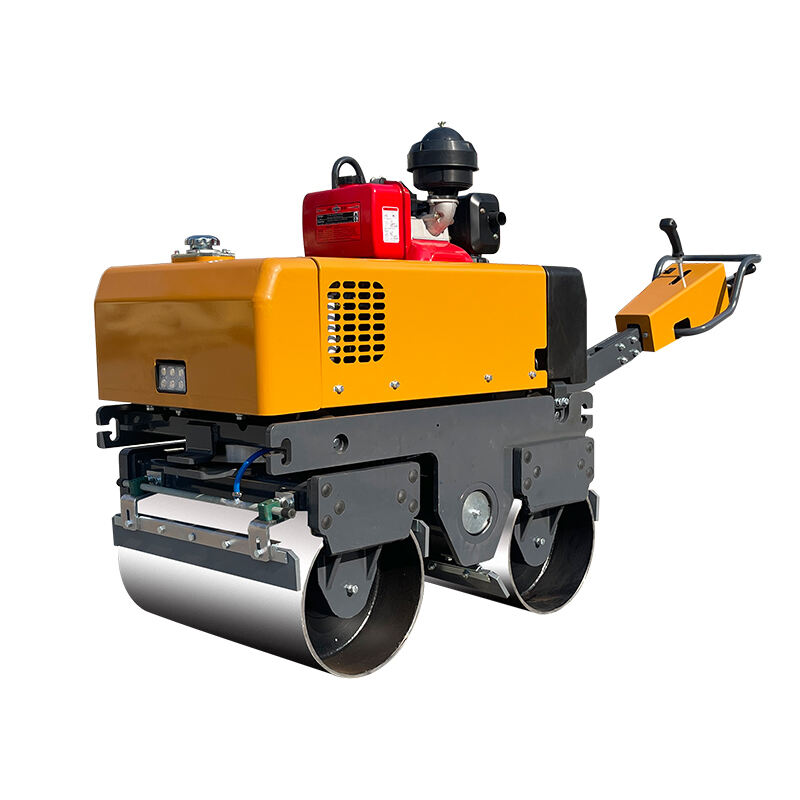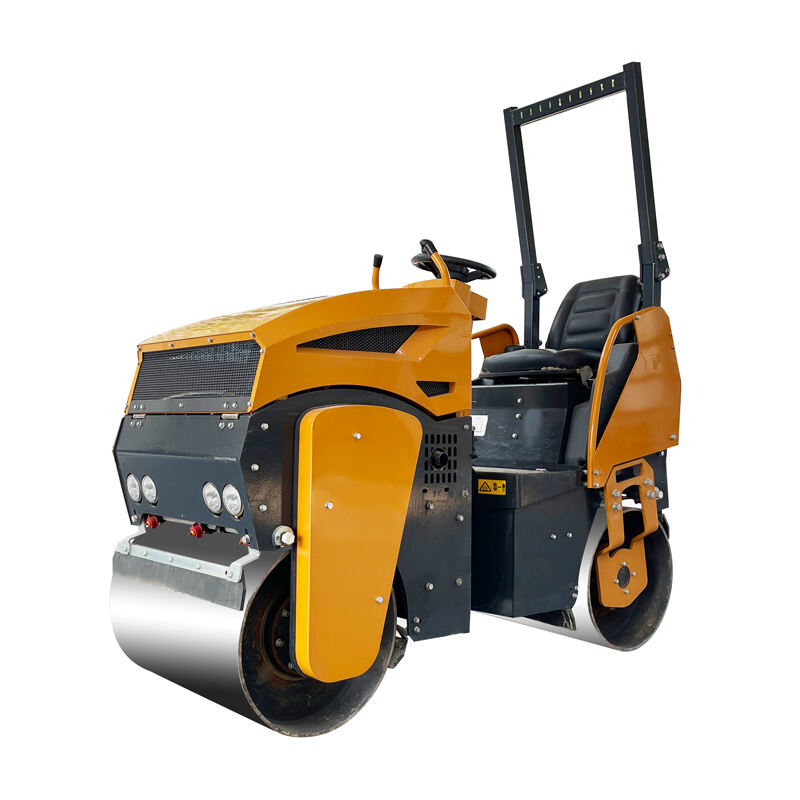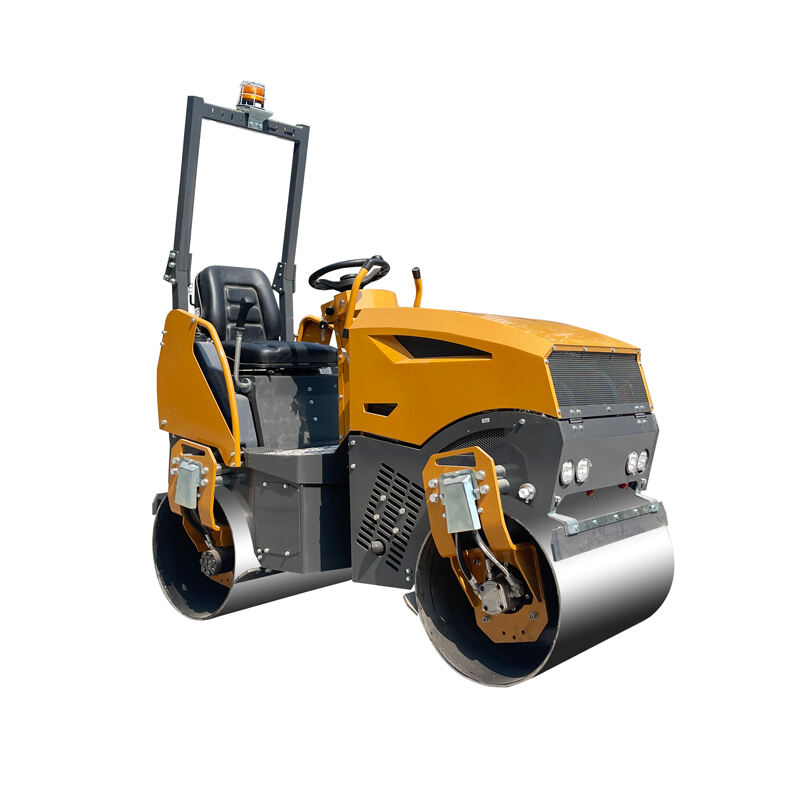Ვიბრაციული გამჭერის მოდერნიზების მთავარი მახასიათებლები
Განსაკუთრებით მნიშვნელოვანი ინოვაციები ვიბრაციულ დაწყარავებში
Ჰიდრაულიკური სისტემები და ვიბრაციის კონტროლი
Ჰიდრავლიკური სისტემების გამოყენება მექანიზმებში ამ მანქანების მუშაობის პროცესში მნიშვნელოვან წინ გადადგმულ ნაბიჯს წარმოადგენს. ეს სისტემები ოპერატორებს უფრო ზუსტ კონტროლს სძლევს როგორც ძალის, ასევე რხევის დონის მიმართ მუშაობის დროს, რაც საშუალებას გვაძლევს უფრო იოლად მართოთ კომპაქტურობის პროცესი საშენ მოედანზე. პრაქტიკულად ეს იმას ნიშნავს, რომ მშენებლები უკეთეს შედეგებს იღებენ ხელით ზედმეტი დატვირთვის გარეშე. ასევე მნიშვნელოვანია რხევის კონტროლის ტექნოლოგია. ის აკავებს ზედმეტ კომპაქტურობას, რაც ფულის დაზოგვას უზრუნველყოფს, ვინაიდან სამუშაოს დასრულების შემდეგ ნაკლები ნარჩენი მასალა რჩება. ინდუსტრიის მონაცემები საკმაოდ შთამბეჭდავ რიცხვებს აჩვენებს, როდესაც ვიხილავთ ამ გაუმჯობესებების შედეგებს. საშუალოდ მშენებლები აღნიშნავენ დაახლოებით 20%-ით ნაკლებ დანახარჯ მასალაზე, ხოლო პროექტები დასრულდება დაახლოებით 15%-ით უფრო სწრაფად მთელი პროცესის განმავლობაში მაღალი კომპაქტურობის ხარისხის ხარჯზე. იმ სამშენებლო ფირმებისთვის, რომლებიც მუშაობენ შეზღუდული ბიუჯეტით და მომთხოვნი გრაფიკებით, ასეთი სახის ეფექტურობა ბაზარზე კონკურენტუნარიანობის შესანარჩუნებლად ყველაფერს განსაკუთრებულ მნიშვნელობას ანიჭებს.
Განვითარებული გარის დიზაინი უკეთესი დაწყარავისთვის
Ბოლო განვითარებები ცილინდრების კონსტრუქციაში ამარაგების საქმეში მნიშვნელოვან განსხვავებას ქმნის, რადგან ინჟინრებმა გადააკეთეს ცილინდრების დიზაინი, რათა ისინი მუშაობის დროს მეტ მიწას შეხებოდნენ, რაც მთელი ადგილის უკეთ დატკეპნის ნიშნავს. ახლა ვხედავთ სხვადასხვა ცილინდრების კონფიგურაციებს - ზოგი იძრავს, ხოლო ზოგი კი ნაწილებისგან შედგება, რომლებიც დამოუკიდებლად მოძრაობენ. ეს ვარიანტები უკეთ უმკლავდებიან ყველაფერს ქვიშიანი მიწიდან დაწყებული თიხნარ მიწამდე, ძველი მოდელების შედარებით. მოწყობილობების მიხედვით, ახალი ცილინდრების ტექნოლოგიამ დატკეპნის მაჩვენებელი დაახლოებით 30 პროცენტით გაზარდა რთულ ადგილებში, სადაც ტრადიციული მანქანები საქმეს სრულიად ვერ ახერხებდნენ. ეს გაუმჯობესება კი უფრო ნაკლებ პრობლემას იწვევს მომდევნო პროცესში არასწორად დატკეპნილ მიწაზე აგებული სტრუქტურებთან დაკავშირებით.
Ინტელექტუალური სიხშირის რეგულირების ტექნოლოგია
Იმ სიხშირეების გაზომვის შესაძლებლობამ, რომლებიც განსაზღვრულია ინტელექტუალურად, შეცვალა იმდენად მოქნილი ვიბრაციული როლერის კომპაქტორების ადაპტირება. ოპერატორებს ახლა შეუძლიათ შეეხოთ მათი კომპრესიის სამუშაოს იმის მიხედვით, თუ როგორი მასალის მუშაობა მოეთხოვებათ. როდესაც ეს მანქანები თვითონ იცვლიან მათ ვიბრაციის სიჩქარეს, ისინი ზოგავენ ენერგიას და ამცირებენ ძალის საჭიროებებს, რაც მწვანე მშენებლებისთვის ძალიან მნიშვნელოვანია. საიდუმლო ტესტების შედეგებიც საკმარისად შესანიშნავია. ზოგიერთ სამშენებლო მოედანზე ენერგიის დაზოგვა დაახლოებით 25% იყო ამ სიხშირის კონტროლის ტექნოლოგიის გამოყენებისას. ეს გაუმჯობესებები ნიშნავს პროექტების სრულ ეფექტურობას. მასალები სწორად იკუმშება ძალისხმეულობის გარეშე. ზედაპირები უფრო მეტ ხანს გრძელდება ზუსტი მუშაობის გამო. და უნდა ვისაუბროთ, ელექტროენერგიის დაზოგვა ხარჯების შესახებ ზრუნვასთან ერთად კიდევ უფრო მეტი საიდუმლო შედეგების მიღებას უზრუნველყოფს იმ კონტრაქტორებისთვის, რომლებიც ინერციულად ინახავენ როგორც ხარჯებს, ასევე ნახშირბადის საფეხურს.
Top-Performing Vibratory Roller Models
SVH80 | 800KG | Handheld Double Drum Design
SVH80 ვიბრაციული როლერი საკმაოდ შთამბეჭდავია მისი პატარა ზომისა და მარტივად მართვადობის გამო. გასაგებია, რატომ უყვართ ადამიანებს მისი გამოყენება ქალაქებში მართლაც ვიწრო ადგილებში, სადაც უფრო დიდი მანქანები უბრალოდ ვერ შეხვებიან. რა უზრუნველყოფს ამ კონკრეტული მოდელის კარგ მუშაობას? მას აქვს ხელსაწყოს მსგავსი ორმაგი დრუნის კონფიგურაცია, რომელიც ზედაპირებს ეფექტურად ატეხავს მაშინაც კი, როდესაც ადგილი მართლაც შეზღუდულია. ადამიანები, რომლებიც ამ მანქანების მუშაობაში არიან ჩართულნი, საუბრობენ მარტივად გამოსაყენებელ სამართავ ღილაკებზე და მთლიანად მართვადობის მაღალ დონეზე, როდესაც უხეშ სამუშაო პირობებში მოძრაობენ. შეხედეთ რიცხვებსაც, ბოლო დროს მომხმარებლებისგან მიღებული ინფორმაცია საკმაოდ მყარია. მშენებლები სხვადასხვა რეგიონებიდან აღნიშნავენ, რომ ამ მანქანაზე ყოველდღიურად იმყოფებიან დაუშვებელი პრობლემების გარეშე.
SVH70 | 800kg | მოსული მოქმედება საშუალება
SVH70-ის მოწყობილობა განსაკუთრებით გამოირჩევა იმით, რომ ის საშუალებას აძლევს სამუშაო უფრო სწრაფად შეასრულოთ, ამასთან მუშაობის პროცესში მასონების კომფორტულ განწყობას უზრუნველყოფს. ამ მანქანის განსაკუთრებულობას უზრუნველყოფს მისი კომპაქტური დიზაინი, რითაც ის საუკეთესოდ გადაადგილდება სხვადასხვა სამშენ მოედნებზე, ამიტომ ის საუკეთესოდ გამოიყენება სხვადასხვა გზის მშენებლობის პროექტებში. მანქანის მუშაობის პროცესში ჩართული პირები აღნიშნავენ მისი მართვის მარტივობას, რაც ნიშნავს დაუსვენებელ მუშაობას და მეტი საფარის გადაწყვეტას. სამუშაო პრაქტიკა აჩვენებს, რომ მუშაებს სინამდვილეში სურთ ამ მოწყობილობის გამოყენება, რადგან ყველაფერი მართებულად არის გაკეთებული, მართვის სისტემიდან დაწყებული და სამუშაო ადგილის მდებარეობით დამთავრებული. ერგონომიკა მნიშვნელოვნად ამცირებს დაღლილობას გრძელ სამუშაო სმენების დროს.
ST1000 | 1-ტონიანი არტიკულირებული ფრეიმის მოდელი
ST1000 როლერი არტიკულირებული ჩარჩოთი არის დამაგრებული, რაც მნიშვნელოვნად აადვილებს მუშაობას არაგლუვ ტერიტორიებზე და განსაკუთრებით გამოირჩევა რთულ პირობებში, სადაც სხვა მანქანები გარკვეულ სირთულეებს განიცდიან. მასთან გამოყენებული კონტრაქტორების შეფასებით, აღნიშნული მოდელი უფრო კარგ შედეგებს იძლევა ბარიერების დაძლევისას და ამავდროულად შეინარჩუნებს კარგ დატკეპნის მაჩვენებლებს სხვადასხვა ზედაპირებზე. ბაზარზე არსებული მსგავსი როლერების შედარებით, ST1000-ს გადაადგილება გაცილებით უფრო მარტივია ზემოაღნიშნული მოქნილი ჩარჩოს ხარჯზე. ეს კი ნიშნავს, რომ მომხმარებლები უფრო სწრაფად მუშაობენ ხარისხის შელახვის გარეშე, რაც განსაკუთრებით მნიშვნელოვანია გზების მშენებლობისას ან დიდი მაშტაბის სამშენებლო მოედნებზე, სადაც დრო მნიშვნელოვან როლს თამაშობს.
ST1200 | 1.2-ტონიანი მაღალი ტორქის კომპაქტირებელი
ST1200 ვიბრაციული რულონი ფაქტობრივად დიდ ძალას უზრუნველყოფს, რაც მას ჭკვიან მუშად ხდის იმ მშრალ კომპაქტურ სამუშაოებზე, რომლებიც მშენებლობის ადგილებზე ან გზების შენარჩუნების პროექტების დროს ხდება. იმ კონტრაქტორებმა, რომლებმაც ეს მანქანა იყენეს, აღნიშნულია, რომ ის უმკლავდება უფრო მომთხოვნი ნიადაგის პირობებს დაუღლელად. ოპერატორებს უყვართ მისი დამოუკიდებლობა დღიდან დღეში. ბევრი ამბობს, რომ ის ხელს უწყობს ერთგვარი შედეგების მიღებას გრძელი სვეტების განმავლობაში, რაც ყოველთვის გადადის ხარისხის შემოწმებას. ზოგიერთი გუნდი ამ რულონების წელზე გამოყენებას ახდენს და კვლავ იპოვის მათ მასალის გამძლეობასა და გახმარებას.
ST1300 | 1.3-ტონიანი Kubota-მotorized Excellence
ST1300 როლერი თავის ძალას იღებს Kubota-ს საუკეთესო ძრავიდან, რაც უზრუნველყოფს მის მაღალ მახასიათებლებს და საიმედოობას ნებისმიერ სამუშაოში, რომელსაც ის ასრულებს. ამ მოწყობილობის შესახებ სამუშაო პირობებში გამოცდილი ინჟინრების მიმოხილვებიც ადასტურებენ მასზე წარმოდგენილ მოლოდინებს, რადგან მათ აღნიშნული აქვთ კარგი შედეგების მიღება სხვადასხვა სამშენებლო პროექტებში მისი გამოყენებისას. გარდა ამისა, ST1300-მა ბოლო დროს რამდენიმე ჯილდო მოიგო მისი გამჭვირვალო დიზაინისა და მაღალი გამძლეობის გამო ოპერაციების დროს. იმ ადამიანებისთვის, ვინც დიდ სამშენებლო მოედნებზე მუშაობს და სადაც მოწყობილობები უნდა გაუძლონ რთულ პირობებს, ეს მოდელი თავის კონკურენტებს შორის გამძლეობით გამოირჩევა, რადგან ის არ იშლება და უწყვეტად მუშაობს.
Მოდერნული გზების მომწიფეობის როლერების გამოყენება
Ასფალტის ფართო კომპაქტირების ტექნიკები
Ასფალტის დატკეპნა გზების მშენებლობის ეტაპზე ერთ-ერთი ყველაზე მნიშვნელოვანი პროცესია, რადგან პირდაპირ განსაზღვრავს გზის სიგრძეს შეკეთებამდე. ხელშემწყობები ხშირად იყენებენ სპეციალურ მანქანებს, როგორიცაა ვიბრაციული რულონები, რათა მიიღონ საჭირო სისქე და გლუვი ზედაპირი ასფალტის ფენებში. რა განსაზღვრავს ამ მანქანების ეფექტურობას? ისინი ასფალტის მასას უმაღლესი სიხშირით ახარშავენ, რითაც მცირე ასფალტის ნაჭრები ერთმანეთს უმაგრდებიან და მიიღება გრძელვადიანი და ძლიერი სტრუქტურა, ვიდრე ძველი მეთოდებით მიღებული. კარგი დატკეპნა ბიუჯეტის თანახმადაც მნიშვნელოვანია, რადგან არასწორად დატკეპნილი გზები უფრო ადრე ი cracks, რაც ქალაქებისთვის დამატებით ხარჯებს უტაცებს მომდევნო შეკეთებების დროს. ზოგიერთი კვლევა აჩვენებს, რომ გზები, რომლებიც აშენდა თანამედროვე ვიბრაციული რულონებით, დაახლოებით 30%-ით გრძელ ვადიანად რჩება კარგ მდგომარეობაში ათწლეულების წინ გამოყენებული ტრადიციული მეთოდებით აშენებულ გზებთან შედარებით.
Ტრენის შევსების გამოწვევის ამოხსნები
Ვიბრაციული როლერები აუცილებელია მილთა მოქცევის დასამაგრებლად და საჭირო მიწის დატკეპვის საუკეთესო შესრულებისთვის. როდესაც ოპერატორები ამ მანქანებით ავსებულ მილთა ზემოთ გადადიან, ისინი მიწას მკაცრად ატკეპავენ, რაც აჩერებს პრობლემებს, როგორიცაა მიწის დაშლა ან ეროზია, რამაც შეიძლება დაზიანოს ნაგებობა, რაც ზემოთ მდებარეობს. ზოგიერთი სამოქალაქო საინჟინრო კვლევა მიუთითებს იმაზე, რომ მიწის სწორად დატკეპვისას დაშლა დაახლოებით 50%-ით ნაკლებია. მთავარია სინათლის შემცველობის სწორად მორგება სამუშაოდ დაწყებამდე, ასევე თხელი ფენების დამუშავება მანამ, სანამ მიწის მდგრადი მდგომარეობის სპეციფიკაციები შესრულდება. უმეტესობა სახელმძღვანელოებისა ასახავს იმ მნიშვნელობას, თუ როგორ მნიშვნელოვანია მილებში ერთგვაროვანი სიმკვრივის მიღწევა, თუ გვინდა მაღალი ხარისხის ნაგებობების მიღება. ამას ინდუსტრიული მონაცემებიც უჭერს მხარს, რადგან საშენ პროექტების დასრულების შემდეგ იშვიათად გვხვდება ჩამქვეითებული ფუძეების საჩივრები სწორად გაკეთებული როლერის გატარების შემთხვევაში.
Მოხსნილი მოდელების გამოყენება წინააღმდეგად მოდელებს, რომლებიც მოხსნილია
Როდესაც აირჩევს სამუშაოდ საჭირო როლიკს, უკან სადგომ და მავალ როლიკს შორის, უმეტესობა ხელის მოსაწყობელის სამუშაოს ტიპზე და მის მოცულობაზე აკეთებს დასკვნას. პატარა სამუშაოების შემთხვევაში, სადაც ადგილი შეზღუდულია და სამუშაო პროცესი ინტენსიური არ არის, უფრო ხშირად ირჩევენ უკან სადგომ როლიკებს, რადგან ისინი იოლად შედიან ვიწრო ადგილებში. მავალი როლიკები უფრო მარტივად გადახატავს დიდ ტერიტორიებს და არ აღვიძლებს სამუშაო გუნდს. დიდი მანქანები უფრო მარტივად და სწრაფად ასრულებს სამუშაოს, რადგან მათ მომხმარებელი სამუშაოს განმავლობაში ინარჩუნებს კომფორტულ მდგომარეობას. გამოცდილი პროფესიონალები ყვებიან, რომ მავალი როლიკები უფრო ხშირად გვხვდებიან დიდი სამუშაოების დროს, სადაც საჭიროა მიწის დატკეპვა, ხოლო უკან სადგომი როლიკები გამოუყენებელია იმ ადგილებში, სადაც საჭიროა შესვლა შენობის უკანა კუთხეებში ან არსებული სტრუქტურების გასწვრივ. ამ სამუშაო მანქანების განსხვავება მხოლოდ თეორიული ცოდნა არ არის, არამედ პროექტის დასრულების დროზე და ბიუჯეტზე ასევე მოქმედებს.
Ეფექტურობის მონაწილეობა განვითარებულ კომპაქტერებში
Საწვავის გამოყენების ოპტიმიზაცია განათლებული სისტემების მეშვეობით
Ახალი თაობის კომპაქტორები საშენ სამუშაოებს ისე გადაადგილებენ, რომ მათი ინტელექტუალური ტექნოლოგიები მნიშვნულად ამცირებენ საწვავის ხარჯვას. აპარატის სისტემები აგროვებენ ინფორმაციას გარემოზე და ასრულებენ საჭირო კორექტირებას ძრავის მუშაობაში, რათა იგი ეფექტუალურად იმუშაოს და საკმარისი მომსახურება გაუწიოს რთულ სამუშაოებს. ზოგიერთი კონტრაქტორის გამოცდილება აჩვენებს, რომ ახალი მანქანების გამოყენებით საწვავზე დახარჯული თანხები 15 პროცენტით შემცირდა. საწვავის ნაკლები ხარჯვა ფულის დაზოგვას ნიშნავს, მაგრამ ასევე არის კიდევ ერთი დიდი დამატებითი უპირატესობა – ზიანის შემცირება გარემოზე, რადგან ნაკლები მავნე აირები გამოიყოფა. ეს მნიშვნულოვან განსხვავებას ქმნის გარემოსთან დაკავშირებით, ვინაიდან სამშენი მოედნები ხშირად არიან დაბინძურების წყაროები. სუფთა ჰაერის მიღწევა ამ სამუშაო პროცესებიდან ნამდვილად გვეხმარება გლობალური გათბობის პრობლემების წინააღმდეგ ბრძოლაში და სამუშაო ადგილების გამწვანებაში.
Დაკარგული მუშაობის შემცირება მძიმე კომპონენტებით
Თანამედროვე კომპაქტორებში გამაგრებული მასალების და ხარისხიანი კომპონენტების გამოყენება ნიშნავს, რომ ისინი არ სჭირდებათ მუდმივი შეკეთება და დახვეწა. როდესაც მწარმოებლები აშენებენ თავიანთ მანქანებს მაგრამ იმ მასალებით, რომლებიც შეუძლიათ გაუმკლავდნენ მძიმე პირობებს, ეს ითარგმნება უფრო იშვიათი გამტეხილობით და შეკეთებაზე გატარებული ნაკლები დროით. შეხედეთ, რას აჩვენებს რიცხვითი მაგალითი საინდუსტრიო მონაცემებისაგან. ერთმა კვლევამ აჩვენა, რომ კომპანიებმა დაუშვეს დაახლოებით 20 პროცენტით ნაკლები ხარჯი შეკეთებაზე უფრო ხარისხიანი მოდელებზე გადასვლის შემდეგ. იმ ადამიანებმა, რომლებსაც აქვთ მოწყობილობების შეკეთებასთან დაკავშირებული გამოცდილება, ხშირად ასახავენ რაღაც მნიშვნელოვანს გამძლეობის შესახებ. ხარისხიანი მანქანები ნაკლებ ხარჯს გულისხმობს, დიახ, მაგრამ ისინი ასევე ამაღლებენ პროდუქტიულობას, რადგან დროთა განმავლობაში ნაკლები პრობლემა ხდება. ნაკლები დროის დახარჯვა რამის შესაკეთებლად ნიშნავს მეტი სამუშაოს შესრულებას.
Გრადირების გაუმჯობესება ხილების ზედაპირებზე
Კომპაქტორების დიზაინში ბოლო გაუმჯობესებებმა მნიშვნულად გააუმჯობესა უბედური და დახრილი სამუშაო პირობების მოგვარება აშენებისას. დღევანდელი კომპაქტორები უკეთ უხვევენ ამაღლებებს, ვიდრე რამდენიმე წელზე უკან არსებული მოწყობილობები. ტესტები აჩვენებენ, რომ ისინი შეძლებენ ასვლას დახრილობაზე, რომელიც ძველი მოდელების შედარებით 30 პროცენტით მეტია. გზის მშენებლები, რომლებიც ხშირად მუშაობენ მთიან რაიონებში, საოცარ შედეგებს აღნიშნავენ ახალი მოწყობილობების გამოყენებით. ისინი სამუშაო დასრულებენ უფრო სწრაფად, რადგან მძღოლები აღარ იხატებენ იმდენად სწრაფად მუშაობისას. რეალური სამშენებლო ადგილებიდან მიღებული უკუგვერდი საუბრის არის იმაზე, რომ განახლებული კომპაქტორები არის იმ ადამიანებისთვის სასურველი ალტერნატივა, ვინც უმუშევრობს რთულ ტერიტორიებზე გზის აშენებისას ქვეყნის მასშტაბით.
Ოპერაციული ტექნოლოგიის დარღვევა
CE-სერტიფიცირებული ბეზრის მახასიათებლები
CE სტანდარტების შესაბამისად სერტიფიცირებული უსაფრთხოების შესაძლებლობები ასრულებს მნიშვნელოვან როლს მანქანის მომხმარებლის უსაფრთხოების უზრუნველყოფაში ვიბრაციული როლერის გამოყენებისას. რა განსაზღვრავს ამ შესაძლებლობების განსაკუთრებულ მნიშვნელობას? მაგალითად, გაუმჯობესებული ხილულობა მანქანის გარშემო, ავტომატური გამორთვა გაუმართლების შემთხვევაში და ისეთი დიზაინი, რომელიც განიხილავს მუშათა მუდმივ ურთიერთქმედებას მანქანასთან. სამშენებლო მайдნებზე ასეთი გაუმჯობესებები მნიშვნელოვანწილად შეამცირებს დაზიანებებს და უზრუნველყოფს პროექტების უწყვეტ განხორციელებას. ევროპული უსაფრთხოების და ჯანმრთელობის დაცვის სააგენტოს კვლევის მიხედვით, კომპანიები, რომლებიც იყენებენ ასეთი სისტემებს, აღიარებენ შემთხვევების შემცირებას დაახლოებით 40%-ით. იმ კონტრაქტორებისთვის, რომლებიც უსაფრთხოების მიმართ არიან მიმართულნი, ასეთი ტექნოლოგიების გამოყენება ასაკრძალავს მხოლოდ რეგულაციების შესაბამისობას, არამედ უზრუნველყოფს უსაფრთხო გარემოს მთელი სამშენებლო სექტორისთვის. ამ აუცილებელი სერტიფიცირებული დაცვის გარეშე არც ერთი თანამედროვე მანქანა სრულყოფილი იქნება.
Ჰიდროავტომატური სამრუდო მექანიზმების განმარტება
Ჰიდრავლიკური საჭე სახაზავ როლერ კომპაქტორებზე მშენებლობისას შეზღუდულ სივრცეში გადაადგილების საქმეში მნიშვნელოვნად განსხვავდება. ეს სისტემები მასზე მნიშვნელოვნად უკეთ მართვის საშუალებას აძლევს მანქანებით, ასე რომ ისინი შეიძლება გადავიდნენ ვიწრო ჩიტადამდე და არიდებით არ შეხვიდნენ რაიმე ხელსაწყოს. ძველი საჭე სისტემების შედარებით განსხვავება აშკარად განსხვავდება. ჰიდრავლიკური სისტემები უფრო გლუვად მოქმედებს კუთხეების შეტრიალებისას და მომხმარებლის მიერ გაცილებით ნაკლები ფიზიკური დატვირთვა მოითხოვს. ბევრი ადამიანის აზრით, რომლებიც ამ მანქანების მომხმარებლები არიან, აღნიშნავენ, თუ როგორ ყვება ყველაფერი უფრო მარტივი ხდება ჰიდრავლიკის გადართვის შემდეგ. ისინი აღნიშნავენ, რომ შეუძლიათ უმკლავდეს უხეშ ტერიტორიებს, რომლებიც ადრე თითქმის შეუსაბამისი იყო. იმ კონტრაქტორებისთვის, რომლებიც გზის პროექტებზე მუშაობენ, სადაც დრო მნიშვნელოვანია, კარგი ჰიდრავლიკური საჭეს შეძენა უკვე არ არის მხოლოდ ღირებული – ეს აუცილებელია, თუ ისინი გსურთ დარჩნენ თანამედროვე მოთხოვნებთან ერთად, როგორც სიჩქარის, ასევე სიზუსტის გზის დასაყრდნობად.
Წყალის გამყოფი მანქანის მონაწილეების მონაცემები
Როდესაც ვიბრაციული კომპაქტორებს ვიღებთ მონაწილეობაში, წყლით გაგრილებული ძრავები მოჰყავთ მნიშვნელოვანი უპირატესობები. ისინი უკეთ უმკლავდებიან გაცხელების პრობლემას, როდესაც პირობები რთული ხდება, რაც ნიშნავს, რომ მომხმარებლებს არ უწევთ ძრავის გახურების შესახებ ზრუნვა სამუშაო დღეების განმავლობაში. ასეთი ძრავების და მათი ჰაერით გაგრილებული ანალოგების სიცოცხლის ხანგრძლივობაში არსებული სხვაობა მნიშვნელოვანია. მონაცემები მიუთითებენ, რომ წყლით გაგრილებული ვერსიები დაახლოებით 20 პროცენტით მეტი ხან გრძელდებიან ჩანაცვლებამდე, რადგან ისინი უკეთ უმკლავდებიან სითბოს. უმეტესი ძრავის მწარმოებლების აზრით, ასეთი სისტემები ნაკლებ ხშირად საჭიროებენ მომსახურებას და დროის განმავლობაში უფრო გლუვად მუშაობენ. ამიტომ ბევრი მშენებელი უკვე მიუთითებს წყლით გაგრილებული ძრავების გამოყენებაზე გზების მშენებლობის მანქანებში. საბოლოოდ, არავის სურს გაწყვეტილობების ან არასასურველი სარემონტო სამუშაოების მოწყობა ვადების დასაცავად და პროექტების დასასრულებლად.
Ხელიკრული
Რა არის ძირითადი ინოვაციები ვიბრაციულ როლერის კომპაქტებში?
Მთავარი ინოვაციების შედის ჰიდრავლიკური სისტემების ინტეგრირება ზუსტი ძალისა და ვიბრაციის კონტროლისთვის, დრომის ახალგაზრდული დიზაინი მაქსიმალური ზედაპირის კონტაქტისთვის, გონივრული სიხშირის გარეშე ტექნოლოგია ოპტიმალური ენერგიის გამოყენებისთვის და მაღალი ბრუნვის მომენტის შესაძლებლობები მძიმე კომპაქტური ამოცანებისთვის.
Როგორ გაუმჯობეს ახალი ტამბურის დიზაინები კომპაქტირების ეფექტივობა?
Ახალი ტამბურის დიზაინები შექმნილია მაქსიმალური ზედა კონტაქტის და ერთობლივი კომპაქტირების გასასარგებლად, გაუმჯობეს ეფექტივობას მინიმუმ 30%-ით რთული მიწის პირობებში.
Რა სასიამოვნოები აძლევს ინტელექტუალური სხვაობის რეგულირების ტექნოლოგიები?
Ეს ტექნოლოგიები აძლევს მომხმარებლებს შესაძლებლობას კომპაქტირების დაზუსტება მასალების ტიპების მიხედვით, ენერგიის გამოყენების გაუმჯობესებას, ელექტროენერგიის მომწიფეობის შემცირებას და მასალების კომპრესიის ზუსტობის და მარტივობის გაუმჯობესებას.
Რა განსხვავებაა ხვრელი და მოჭადვის მოდელებს შორის?
Ხვრელი მოდელები არჩევანია მცირე დავალებებისთვის მაღალი მანევრულობით, ხოლო მოჭადვის მოდელები არჩევანია დიდი პროექტებისთვის მაღალი ეფექტივობით და კომფორტით.
Რა განვითარებები წვდომას ახალგაზრდა კომპაქტებში საწვავის გამოყენების გაუმჯობესებისთვის?
Ინტელიგენტული სისტემები იყენებენ რეალ-ტაიმის მონაცემებს, რათა გამოსახულების მუშაობა ჩასწოროს საწვავის ეფექტურობის გაუმჯობესებისთვის, რაც მიიღებს 15%-იან შემცირებას საწვავის ხარჯებში, ძალის შემცირების გარეშე.
 EN
EN
 AR
AR CS
CS DA
DA NL
NL FI
FI FR
FR DE
DE IT
IT NO
NO KO
KO PL
PL PT
PT RO
RO RU
RU ES
ES SV
SV TL
TL ID
ID LV
LV SR
SR SK
SK SL
SL VI
VI SQ
SQ ET
ET TH
TH TR
TR AF
AF MS
MS GA
GA HY
HY KA
KA BS
BS LA
LA MN
MN MY
MY KK
KK UZ
UZ KY
KY












